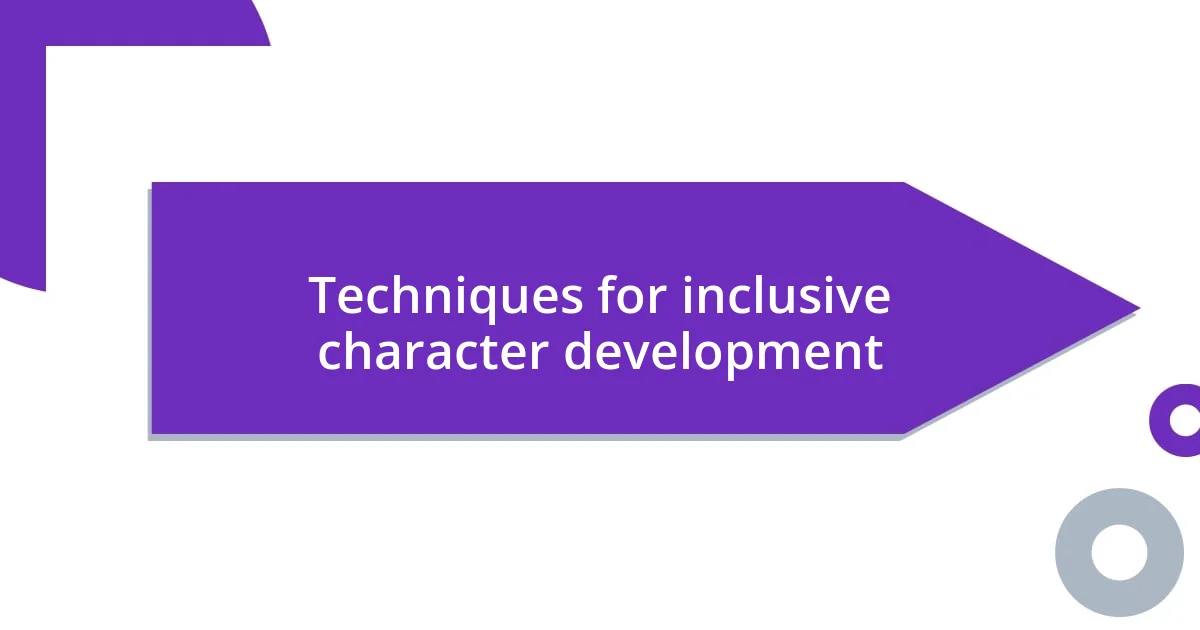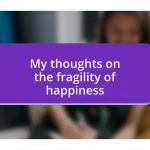Key takeaways:
- Diversity in character creation goes beyond representation; it fosters empathy and encourages nuanced storytelling that resonates with varied audiences.
- Authenticity in characters can challenge stereotypes and deepen narratives, allowing for complex portrayals that illuminate broader societal truths.
- The future of character diversity emphasizes intersectionality, collaboration, and technology, enhancing representation and audience engagement in storytelling.

Understanding diversity in characters
Diversity in character creation isn’t just about representation; it’s about grounding characters in realities that resonate with various audiences. I remember a time when I read a story featuring a protagonist from a culture vastly different from my own. Initially, I felt disconnected, but as the narrative unfolded, I found myself empathizing with their struggles and triumphs. Isn’t that the power of a well-crafted character?
The beauty of diversity lies in the unique perspectives it offers. Consider this: how often do we encounter stereotypes instead of authentic representations? I once worked on a script where the characters’ backgrounds influenced their decisions and relationships in impactful ways. This depth made the story not just relatable but rich with genuine moments that echoed real-life experiences. Does that not inspire us to push beyond the superficial and delve into more authentic portrayals?
Characters that reflect diversity enrich our storytelling landscape by reflecting the world we live in. I find it fascinating how different backgrounds can lead to such varied narratives and character dynamics. When I created a character who was queer and part of a marginalized community, it challenged me to explore facets of identity I had never considered before. This exploration opened doors to conversations about acceptance and understanding, highlighting the importance of making space for voices that often go unheard. Can you see how diverse characters can shift narratives and expand us as storytellers?

Importance of diverse character perspectives
Diverse character perspectives provide a window into different experiences, allowing audiences to connect with stories on a deeper level. I once created a character who came from an immigrant background, anxious about fitting into a new culture. Writing their internal struggles made me reflect on my own experiences of feeling like an outsider, and it struck me how important it is for readers to see these nuanced segments of humanity. These perspectives can transform familiar narratives into vibrant tapestries that challenge preconceived notions.
Here are a few key reasons why diverse character perspectives are crucial:
- Fostering Empathy: Engaging with characters from different backgrounds can help us develop a greater understanding and compassion for ongoing societal issues.
- Encouraging Inclusion: These characters pave the way for underrepresented voices, showing that stories can be told through many different lenses.
- Broadening Narratives: Diverse perspectives add layers to storytelling, creating richer plots that reflect the complexity of our world.
- Challenging Stereotypes: They can dismantle harmful stereotypes by showcasing authenticity, encouraging more honest dialogues about identity.
- Inspiring Creativity: Encountering varied experiences can spark fresh ideas for writers and artists, expanding the possibilities of character development.
Diversity isn’t just a checklist; it’s a catalyst for meaningful storytelling that resonates with everyone.

Overcoming stereotypes in character creation
Overcoming stereotypes in character creation requires a conscious effort to look beyond surface traits and explore the complexities of individuals. I recall working on a story where I had a character who was a librarian, often seen as the quiet, bookish type. Instead of leaning into that stereotype, I developed her into a fierce advocate for literacy in her community, combating socio-economic barriers. This transformation made her relatable and inspiring, ultimately showcasing that people are more than the roles they play; they can be multifaceted and dynamic.
It’s crucial to challenge preconceived notions by diving deeper into the backgrounds and motivations of our characters. One time, I wrote a character who was portrayed as the ‘angry villain’ in many stories. As I fleshed out their backstory, I discovered they were driven by a past trauma that influenced their drastic actions. This process not only made the character more complex but allowed me to portray them in a way that sparked compassion rather than disdain. Have you noticed how adding depth can completely change the narrative around a character?
Stereotypes can not only be harmful but also limit our storytelling potential. In one project, I wanted to create a character with a disability. Instead of defining them solely by their condition, I celebrated their achievements and unique outlook on life. This shift challenged my own perceptions and opened my eyes to the diverse experiences people have. It serves as a reminder that well-rounded characters can illuminate broader truths about society while encouraging acceptance and understanding.
| Stereotype | More Authentic Representation |
|---|---|
| Librarian as quiet, bookish type | Librarian as fierce literacy advocate |
| Angry villain | Villain shaped by past trauma |
| Disabled person defined by their condition | Person with diverse life experiences and achievements |

Techniques for inclusive character development
One effective technique for inclusive character development is actively engaging with real-life experiences of individuals from diverse backgrounds. I remember attending a local cultural festival where I spoke with several attendees about their stories and traditions. This encounter inspired me to create characters who reflect those unique experiences, reminding me that genuine connections can unfold through honest storytelling. How often do we overlook the richness of our own communities in favor of a more generalized narrative?
Another technique is to perform thorough research into the cultures and experiences of the characters we want to portray. I had the opportunity to read firsthand accounts from individuals facing systemic challenges, which greatly informed my writing. Instead of relying on stereotypes, I found that grounding my characters in reality not only made them more relatable but also enriched my narratives. Have you ever considered how much more compelling a character becomes when their traits are backed by real-world complexities?
Additionally, using collaborative feedback can elevate the inclusivity of character development. In one of my workshops, I encouraged fellow writers from different backgrounds to critique each other’s work. The insights I received were incredibly valuable, helping me see biases I hadn’t even recognized in my characters. It taught me that embracing diverse voices in the creative process fosters authenticity and encourages richer storytelling. Isn’t it fascinating how collaboration can push our storytelling boundaries and help us grow?

Balancing diversity and storytelling
Finding the right balance between diversity and storytelling can be a delicate dance. I remember once crafting a fantasy world that was wonderfully diverse, but I realized that, amidst the vibrant characters, the plot felt diluted. It struck me that simply inserting characters from various backgrounds wasn’t enough; their experiences needed to intertwine meaningfully with the narrative. How do we create stories that not only reflect diversity but also resonate emotionally with our readers?
Another time, while developing a character from a marginalized community, I focused on their unique cultural nuances. I wove in their customs, beliefs, and struggles, but I was cautious to ensure these details served the plot rather than overshadowing it. It’s a fine line, isn’t it? I learned that when diversity enriches the story rather than distracts from it, characters become vehicles for deeper themes. Aren’t the best stories those where every voice contributes to the whole tapestry?
I often find that my most impactful moments in storytelling arise when I allow characters to challenge each other, especially across diverse backgrounds. For instance, in one of my scripts, a character from a wealthier background meets a character facing economic hardship. Their interactions not only sparked tension but also fostered understanding and empathy. Isn’t it powerful when diversity drives the story forward, leading us all to become a little more aware of the world around us?

Evaluating diversity in existing works
When evaluating diversity in existing works, I often find myself reflecting on the representation—or lack thereof—seen in popular media. For instance, I recently revisited a classic novel that many celebrate for its storytelling but was struck by how few diverse characters it featured. This absence made me ponder: do we truly understand the impact of such choices on our broader understanding of the human experience?
I recall watching a film that showcased a wonderfully multicultural cast, yet their portrayals felt more like stereotypes than authentic characters. It left me feeling disheartened, realizing how easy it is for creators to slip into old patterns rather than invest the time to genuinely understand their characters’ backgrounds. How can we call something inclusive if it doesn’t resonate with the real diversity of life?
Interestingly, examining works that successfully integrate diverse characters has revealed a treasure trove of approaches. I recently analyzed a television series that depicted complex, multidimensional characters from various backgrounds, each with their struggles woven into the overarching narrative. This combination elevated not just the storyline but also the viewers’ emotional connection, making me realize that thoughtful diversity can transform a good tale into a remarkable one. Isn’t it exciting to explore characters that reflect the world we live in, inviting everyone to find a piece of themselves within those stories?

Future trends in character diversity
As I think about future trends in character diversity, I see a growing emphasis on intersectionality. It’s not just about having diverse characters but ensuring they embody the multifaceted nature of human identity. The other day, I was struck by a novel where a character navigated both their racial identity and their LGBTQ+ experiences. This blend brought depths to their struggles and triumphs that I hadn’t encountered before. Isn’t it fascinating how these overlapping identities can create characters that feel more authentic and relatable?
I’ve noticed that as audiences demand more inclusive and representative stories, creators are responding by expanding their character development. Just recently, I attended a panel discussion featuring writers who emphasized the importance of collaboration with cultural consultants when developing characters from underrepresented backgrounds. Hearing their stories made me realize how invaluable these partnerships can be. What if we could break down the barriers of misunderstanding and create beautifully nuanced characters together?
I envision a future where technology plays a critical role in character diversity as well. With the rise of AI and data analysis, creators have new tools to understand audience preferences and gaps in representation. I recently explored an interactive storytelling platform that allowed readers to influence character backgrounds in real time. The prospect of involving audiences in the character creation process truly excites me — it opens the door for unique narratives that echo a wider range of experiences. How much richer could our stories become if they reflect the diverse voices of those consuming them?














